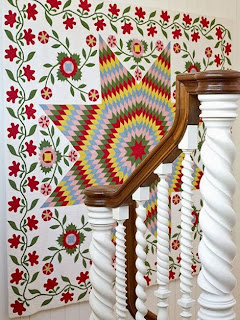Large central star quilts changed when applique fashions changed
in the 1840s.
The rather frilly cut-out chintz details became old-fashioned,
replaced by an interest in the bolder Pennsylvania-German style
florals
Red and green applique began to dominate in that decade.
Providing a clue to date...if the applique is conventional applique
rather than cut-out chintz (Broderie Perse)
the quilt probably dates from 1840 or later.
Lucy Shephard Loomis, dated 1852, Massachusetts
from With Heart and Hands
Often the quilt artist chose a conventional block for the empty spaces, here a Whig Rose or Rose of Sharon
A lovely combination of oak leaf and reel in indigo prints from the
collection of the International Quilt Study Center.
Some Baltimore-ish looking corners and edges.
Carolina Lilies
A nicely balanced piece.
Perfection:
From the Pilgrim-Roy collection on display at the Boston Museum of Fine Arts.
These work so well it's surprising there are not more.
Teddy Pruett is holding a crib quilt
with the star on a different axis.
A silk quilt by Hannah Smith of Brooklyn
in the collection of the Kansas City Museum,
about 1851
The patriotic theme is a subcategory.
Prussian blues and rainbow prints----wow!
Some are more organized than others....
This one is dated 1858-1923
by the Shephard/Temple family
An old black and white picture from the morgue of
the Baltimore Sun
As the 19th century passed we see new trends.
From RickRack Quilts
More color in the background...
From the cover of the California project book
Ho for California....
These intense backgrounds were in favor in southeastern Pennsylvania
from the 1870s into the 20th century.
Mennonite quilt with Princess Feathers corners
From Woodward and Greenstein
The star here is pieced of the new shades of the 20th century, claret red, indigo, gray and black. You don't often see these calicoes combined with applique. As they were coming into fashion, applique was going out.
Except among the various Pennsylvania-German communities.
















nfBL17((CzEQ~~_3.jpg)












































